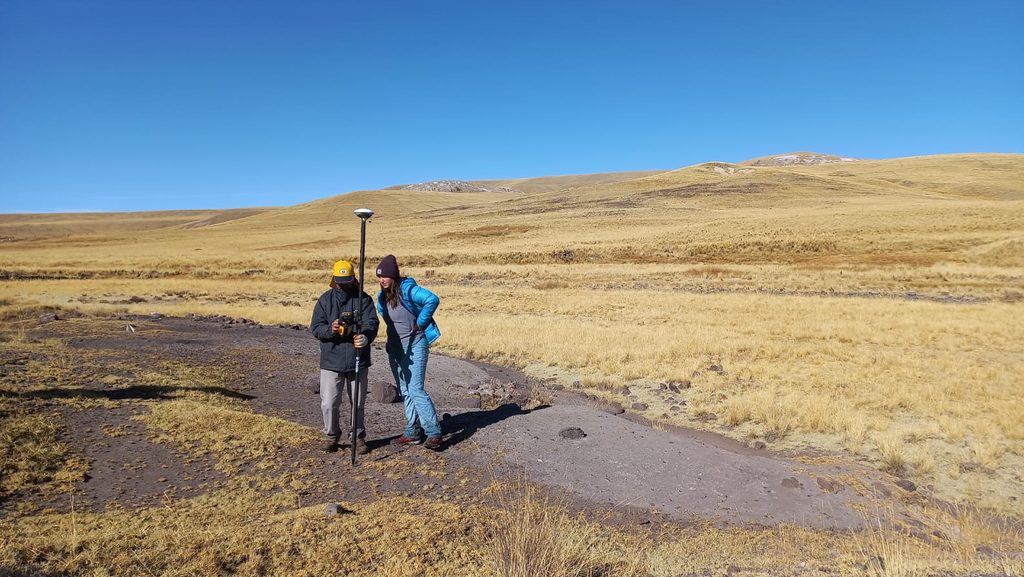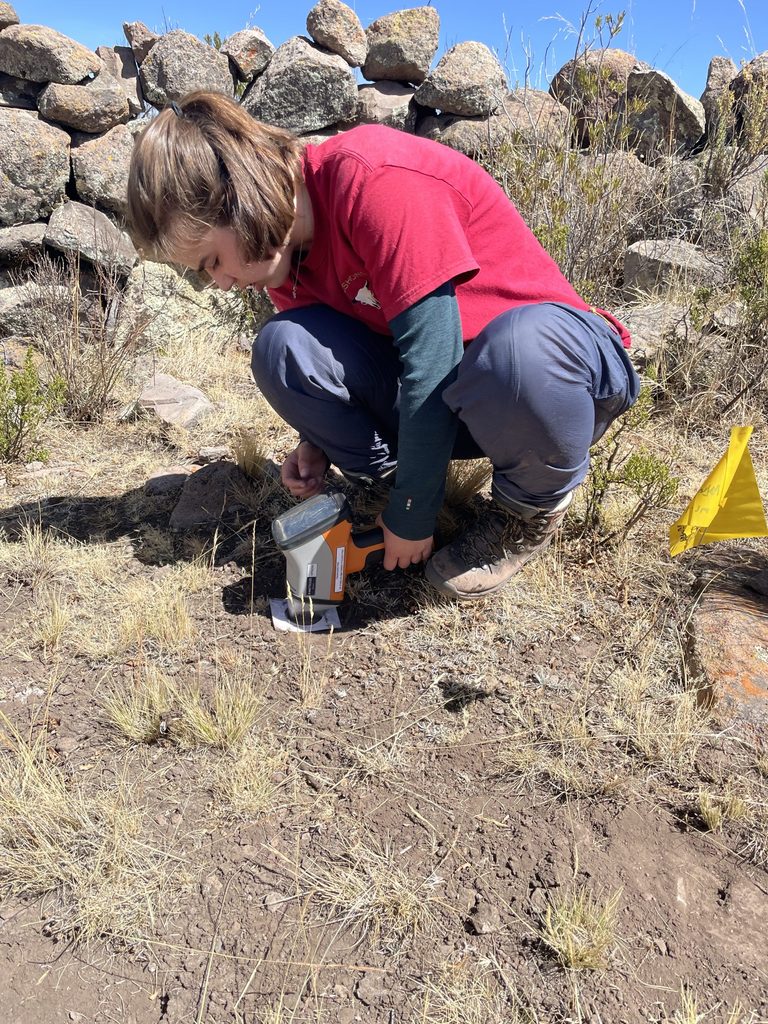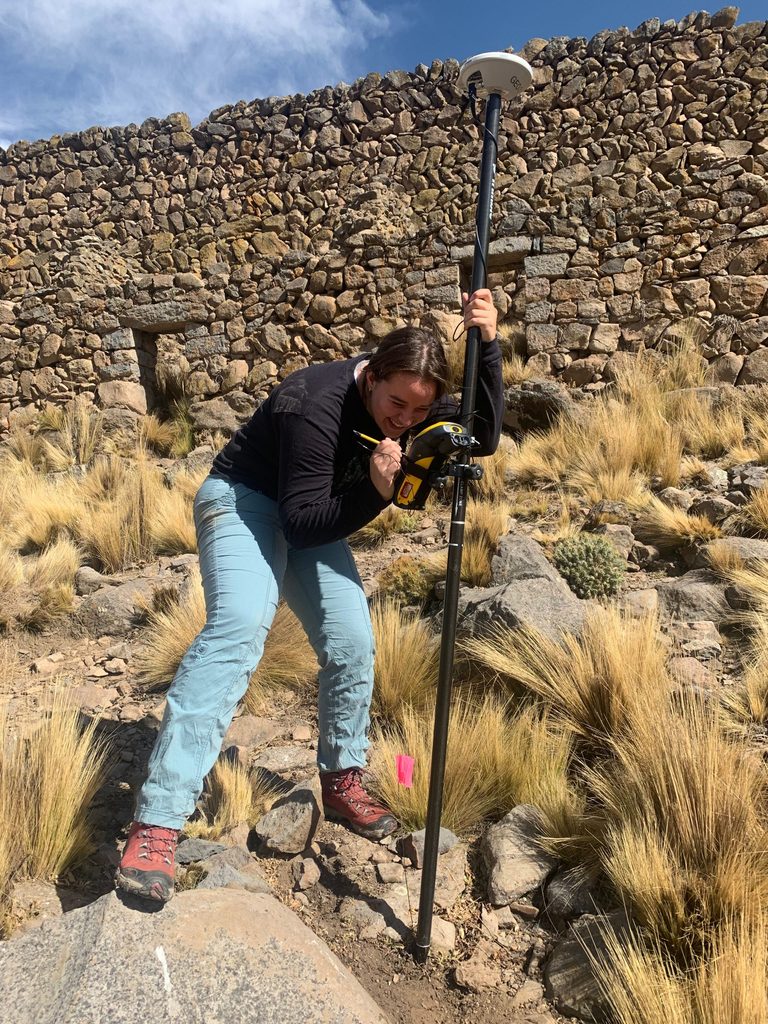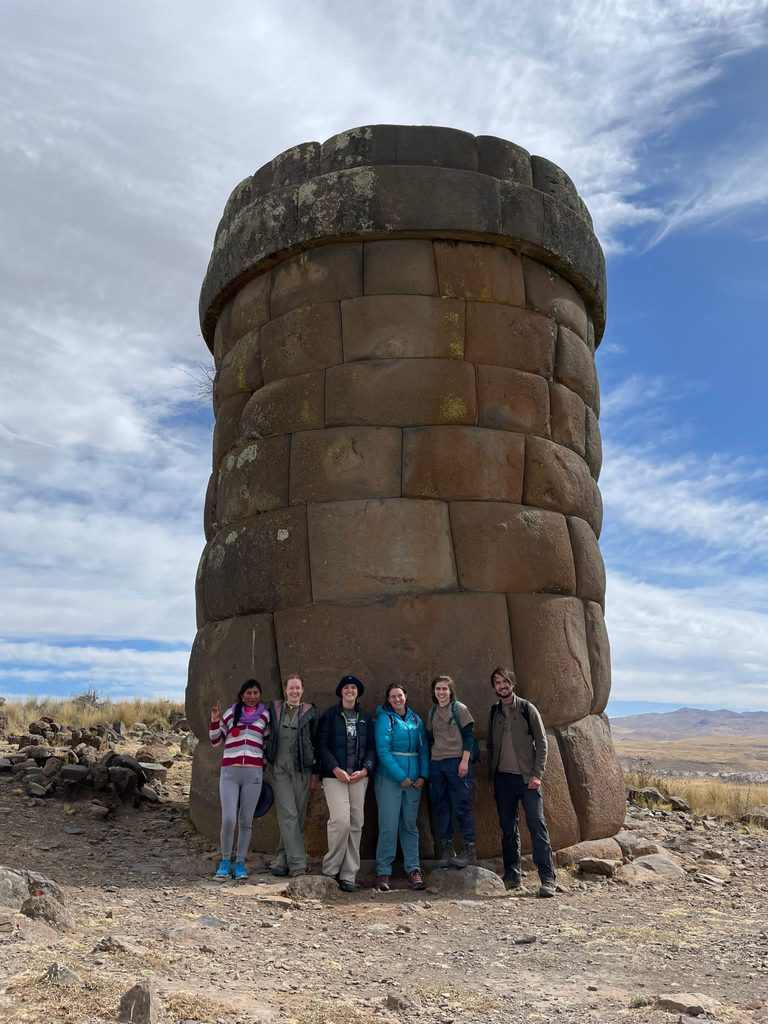[ad_1]
Summer season analysis initiatives enable alternatives for Carleton college students and school to collaborate on necessary work outdoors the classroom. Whether or not it’s a Student Research Partnership (SRP) by way of the Humanities Center, one of many many Integrated Math and Science research fellowships or an unbiased research, Carls take part in a broad spectrum of mental undertakings each summer season.
This yr, Dr. Sarah Kennedy, Robert A. Oden Jr. postdoctoral fellow for innovation within the humanities and archaeology, traveled to Puno, Peru with 5 Carleton college students for her analysis mission entitled “The Ongoing Environmental Impacts of Silver Refining in Peru,” normally referred to by its Spanish acronym PAMA (“Proyecto Arqueológico Medio Ambiente”). 4 of the scholars—Claire Boyle ’25, Collin Kelso ’25, Ezra Kucur ’25 and Kalju Maegi ’23—participated in an SRP and one—Sophie Baggett ’23—was there for an unbiased pupil analysis fellowship. The SRP college students performed archaeological and anthropological fieldwork whereas Baggett, together with her background in Spanish and public well being, established objectives and tips for neighborhood interplay.
The PAMA analysis mission, which extends past these college students’ involvement, was created to evaluate the continuing environmental impression of colonial-era silver refining by establishing a rigorous common survey methodology for the analysis of heavy metals in soils, waterways and vegetation. The fieldwork is integral to a bigger mission objective of decolonizing archaeological and anthropological analysis.

“It’s about figuring out completely different methodological instruments that we are able to use to evaluate heavy metals in archaeological soils,” Kennedy defined, “however we’re additionally constructing on work we’ve carried out beforehand by establishing stronger neighborhood collaborations with Indigenous teams, native Peruvian nonprofits and environmental research organizations to speak well being dangers of those poisonous soils and heavy metals to the communities. Our long-term plans try to determine extra locally-driven initiatives, the place Indigenous teams and native folks residing on and close to these archaeological websites are those asking the analysis questions and main the efforts on learn how to take care of the heavy steel poisoning.”
Kennedy and her collaborators, Peruvian co-director Karen Durand Cáceres of the Ministry of Tradition and Dr. Sarah Kelloway of the College of Sydney, hope that this type of wide-reaching mission will have an effect on your complete subject of archaeology.
“We need to persuade different folks to develop this system,” mentioned Kennedy. “It’s comparatively low price and simple to do, and with it, folks can take a look at websites previous to working in them, [thereby] hopefully stopping varied diseases that may happen from being uncovered to heavy metals. Lots of the people who work at archaeological websites world wide are college students, volunteers and Indigenous or native staff. These are the folks which might be really within the grime and being uncovered to the heavy metals, so I believe it’s necessary to emphasise that this isn’t simply to guard the small proportion of people who find themselves skilled archaeologists on the planet. It’s additionally as a result of we make use of loads of extra marginalized teams.”
As a result of the main target of the mission was on methodology and neighborhood outreach, the sorts of duties Kennedy and her college students completed on their journey weren’t what one may image when prompted to think about “archaeological fieldwork.”

“This was a non-excavation mission,” defined Maegi, who’s a senior sociology/anthropology main and archaeology minor. “It’s all pXRF [portable X-ray fluorescence] samples of soil, water and vegetation, in addition to loads of website mapping and file establishing, gathering and correcting, which is all digital. It’s not the kind of romantic, ‘Let’s placed on our Indiana Jones hat and dig up some pottery and break into folks’s tombs to have a look at mummies’ form of factor. That’s not occurring.”
It might sound lower than thrilling to some; nevertheless, Kennedy and her college students reported that there’s extra to archaeology than digging issues up, particularly in a spot like Puno.
“As a potential geology main,” mentioned sophomore pupil Kelso, “I’m very into nature and there’s no scarcity of pure magnificence at these websites. At one mesa website we went to, we might see the whole lot of this big basin, most likely many tens of miles throughout. The vista was enormous and simply lovely. It’s positively romantic in that regard, regardless that we aren’t doing any digging or choosing up artifacts.”
Maegi agreed and added, “I needed to pinch myself typically. I used to be on prime of a mesa the opposite day in a pre-Inca [Colla] metropolis, wanting down at Lake Umayo, which is immediately adjoining to Lake Titicaca, simply 20 miles away. It was probably the most attractive views I’ve ever seen in my life. As somebody who grew up in Minneapolis, I’m not used to mountains. I used to be like, ‘I’m right here proper now? That is actual?’ It was unimaginable.”
Peru’s placing surroundings was a continuing within the Carls’ day-to-day as they alternated between subject and lab work all through the week.

“Within the subject, we sometimes divided into smaller groups to work on duties,” mentioned Boyle, one other sophomore, “which included laying grids for website surveys, flagging buildings or different areas of curiosity, gathering water and vegetation samples, utilizing the Trimble GPS [data collection hardware] to map the location or file the areas of samples and utilizing the pXRF to take soil measurements.”
“For website visits, we had early wake-ups at 5:30 or 6 a.m. relying on the gap to the location,” added Kucur, additionally a sophomore. “Our closest website was a 20-minute automotive drive and our furthest was an hour drive after which an hour hike up a mesa.”
When the scholars weren’t within the subject, they carried out lab work, which concerned labeling plant or ceramic samples, correcting Trimble GPS knowledge and digital file work. Lab duties additionally included working with Baggett, a senior biology main additionally minoring in Spanish, whose unbiased fellowship served the neighborhood outreach facet of the mission objectives. Her job was in the end to find out the best methods to speak the analysis group’s outcomes as soon as they obtained them.
“I interviewed website landowners, NGO workers and authorities officers to find out each neighborhood information about and present practices for disseminating details about heavy metals,” Baggett mentioned. “Generally I traveled with the group to the archaeological websites, the place I spoke with landowners with the assistance of an Aymara speaker and native archaeologist, Roger [Carazas Losa]. Our long-term objective is to make use of what we realized this yr to extensively distribute the outcomes of Sarah’s archaeological research and current our findings of greatest practices working with the neighborhood.”
The sector and lab work had been optimistic experiences for the scholars, with every of them emphasizing a mix of the attractive environment and the folks they interacted with.
“Attending to work within the panorama of the altiplano in Peru was actually an unimaginable expertise,” mentioned Boyle. “Even in winter, its pure magnificence is actually spectacular and I actually admire spending time there. I additionally cherished attending to work and reside with our group. Not solely have I gotten to know our different Carleton group members a lot better, however we additionally had the chance to work with Australian and Peruvian archaeologists and college students.”
“The panorama and structure of the websites the place we labored was lovely,” Kucur added, “and having the ability to spend lengthy intervals of time there allowed us to actually discover every website. I additionally loved attending to know new folks and dealing with different college students from all around the world. The neighborhood that we created in Peru was wonderful.”
A favourite facet of this kinship creation for Baggett was “‘household dinners,’ the weeknight meals the place we gathered as a group and shared concerning the day’s work whereas making an attempt Peruvian dishes.” The native meals was a standout from the journey—the granadilla, a candy, fragrant fruit, was Kelso’s favourite—with the language and journey alternatives additionally famous as distinctive.

“The immersion was wonderful,” mentioned Kelso. “I really feel like Puno will not be that in contrast to my dwelling metropolis of New York, besides everybody speaks Spanish and it’s a distinct tradition. It was very attention-grabbing and so cool to have the ability to expertise life as you’d in Peru—as a lot as a gringo can, anyway. We additionally did our justifiable share of exploring across the metropolis and neighboring areas like Arequipa, Taquile Island and Cutimbo [a pre-Inca Lupaca archaeology site].”
“I’d say the identical factor, particularly as somebody who hasn’t been afforded too many alternatives to journey in my life,” Maegi mentioned. “I used to be lucky sufficient to see household in Estonia after I was youthful, and Carleton gave me a grant to conduct archaeological analysis in Portugal final yr, however whereas these locations are very completely different from the U.S. in some ways, I by no means actually skilled true tradition shock. Whereas strolling down the road in Puno, simply seeing all these completely different colours and buildings that you just’re not used to, smelling all of the smells and consuming all of the meals, there’s not an entire lot that’s visibly cosmopolitan or particularly Western. It’s distinct from what I conceive of as acquainted, which has been very priceless, particularly by way of skill-building, like studying the language and navigating each cultural unfamiliarities and literal bodily streets.”
This expertise will definitely have an effect on the remainder of their Carleton careers, particularly as a result of three out of the 5 taking part college students are rising sophomores with loads of time left on campus.
“I got here into this journey already desirous to be an archaeology minor,” Kucur mentioned, “so this expertise has solely strengthened that need. I took an archaeology class each time period final yr and I’m taking one other within the fall.”
“This journey has enhanced my understanding and expertise in fields I used to be beforehand inquisitive about,” added Boyle. “I’m particularly grateful for the best way this mission mixed archaeology with geology, as that’s probably my chosen course of research at Carleton.”
Just like Boyle, Kelso’s pursuits additionally lie in each geology and archaeology.
“This gave me the chance to do an archaeological subject research whereas additionally constructing expertise that will likely be very helpful in geology going ahead, like mass spectrometry, GPS knowledge, file correction and that kind of factor,” Kelso mentioned. “That is additionally fairly an interdisciplinary journey, as most of [the SRP trips] are, I believe. We’ve bought an intersection of public well being, geology and archaeology. It’s very ‘Carleton.’”
For Maegi and Baggett, as seniors, the journey enriched their already-established majors and minors and cemented a ardour for journey. Maegi, as a result of his credit score distribution as a switch pupil, solely has one time period left—naturally, he’ll be spending it abroad.

“Puno is topographically, climatically, linguistically and culturally not proximate to what’s acquainted to me and that’s why I like to journey,” he mentioned. “That’s why I need to proceed to journey, to show myself to that unfamiliarity, [so] I’m going to Morocco for my research overseas as my final time period as a Carl. After that, I’ve utilized to show English in Spain beginning subsequent January and I’m additionally within the means of making use of for a Fulbright that may start fall of 2023, which is thrilling. My plans are definitely foreign-oriented!”
Kennedy’s summer season analysis mission has been very fulfilling for her college students. They encourage different Carls to make the most of all their obtainable alternatives, whether or not it’s an SRP over the summer season, an Off-Campus Studies (OCS) program throughout time period or a fellowship after they go away Carleton.
“We’re getting primarily an all-expenses-paid journey besides meals to come back and work in Peru for a month,” Maegi mentioned. “Who wouldn’t need to try this? If one thing like that is enticing to you, don’t be afraid to go for it, particularly if cash is the issue. There are such a lot of alternatives at this little school in Northfield, Minnesota of all locations that may take you nearly wherever. Ask folks within the fellowship workplace, folks in OCS and your professors what sources they’ve for you, as a result of they do have them… And that’s what this liberal arts schooling is all about, proper?”
College inquisitive about making use of for subsequent yr’s Scholar Analysis Partnerships ought to direct any inquiries to Clara Hardy. College students inquisitive about taking part ought to inform their professors whose analysis they discover intriguing. For all non-SRP fellowship info, go to the Office of Student Fellowships.
Erica Helgerud ’20 is the information and social media supervisor for Carleton School.
[ad_2]
Source link


Recent Comments